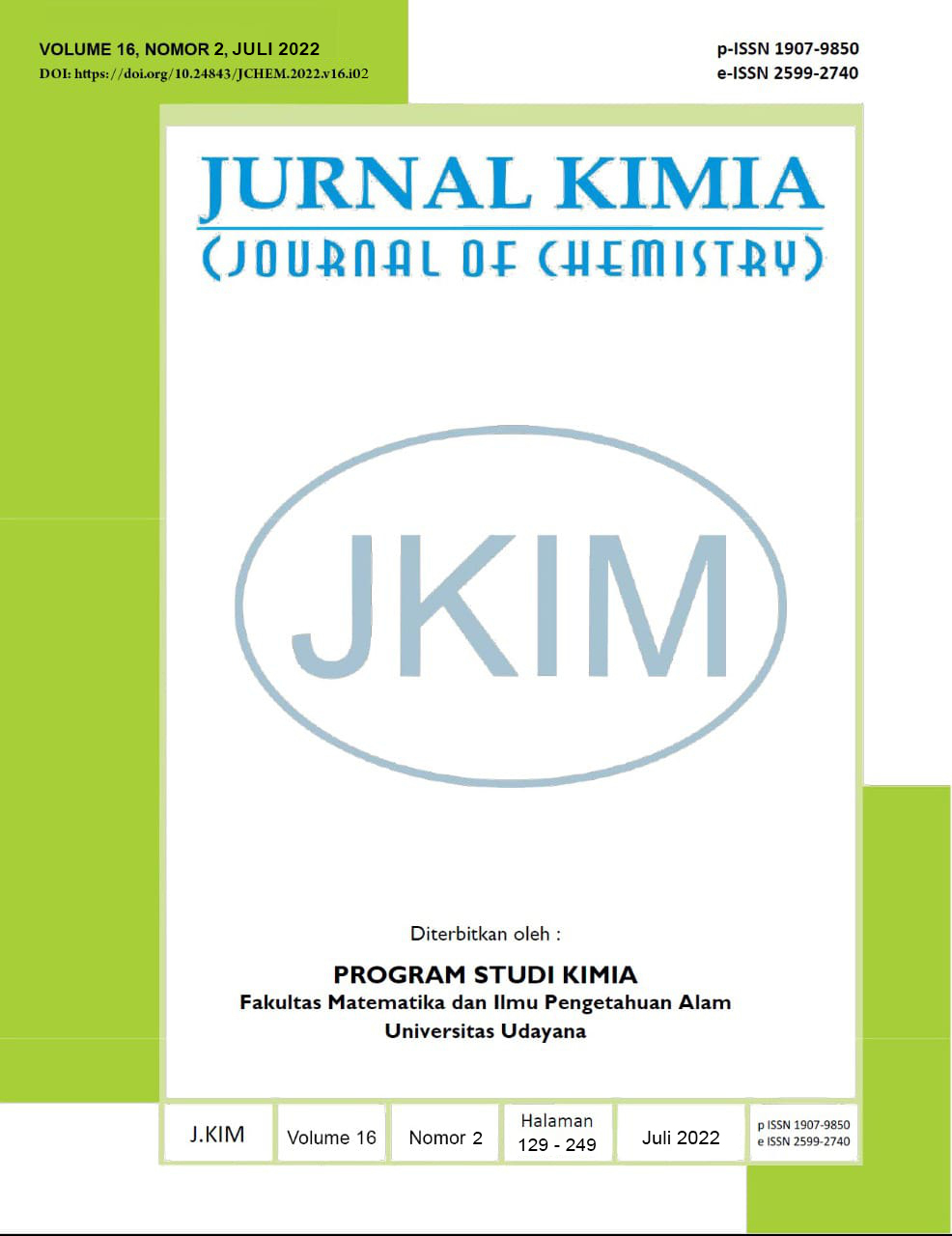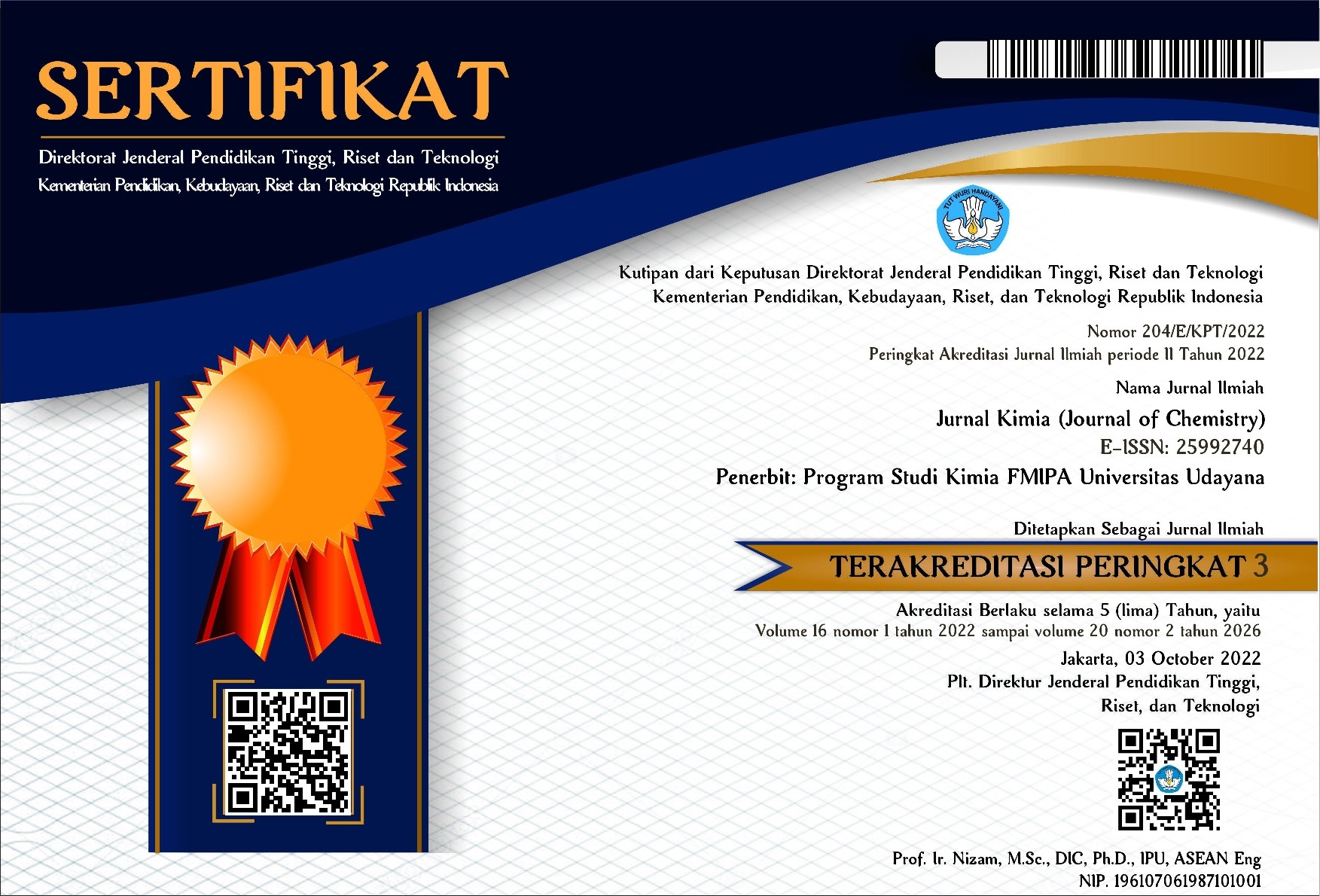PEMANFAATAN ZEOLIT-BENTONIT SEBAGAI ADSORBEN FOSFAT DALAM AIR
Abstract
Salah satu cara yang dilakukan untuk menurunkan kadar fosfat dalam air yaitu dengan cara adsorpsi. Adsorpsi dianggap sebagai metode pengolahan limbah air terbaik karena bahan utamanya yaitu adsorben keberadaannya melimpah dan mudah digunakan. Penelitian ini dilakukan untuk mengetahui kemampuan zeolit yang dikombinasikan dengan bentonit dalam mengadsorpsi fosfat dalam air, menentukan waktu optimum, pola isoterm adsorpsinya serta kapasitas adsorpsi. Kajian yang dilakukan meliputi karakterisasi, dan aplikasinya untuk mengadsorpsi fosfat dengan berbagai variasi waktu kontak dan konsentrasi. Adsorben dikarakterisasi luas permukaan dengan adsorpsi metilen biru dan situs aktif secara titrasi asam-basa. Luas permukaan spesifik masing-masing adsorben nilainya hampir sama, namun yang paling besar adalah kombinasi zeolit : bentonit (1:1) yaitu 45,9637 m2/g. Situs aktif terbesar terdapat pada adsorben kombinasi zeolit : bentonit (1:1) yaitu 1,2842×1024 situs/g adsorben. Semua adsorben kombinasi zeolit : bentonit memiliki waktu kontak optimum yang sama yaitu 24 jam. Adsorben yang terdiri dari zeolite saja atau zeolit : bentonit (5:0) mengikuti pola isoterm adsorpsi Langmuir, sedangkan zeolit : bentonit (1:1) mengikuti pola isoterm Freundlich. Adsorben zeolit : bentonit (5:0), (1:1), dan (0:5) memiliki kapasitas adsorpsi yang optimum pada konsentrasi 100 ppm dengan persen teradsorpsi berturut-turut 96,66; 97,67; dan 97,02 %, sehingga dapat dilihat bahwa adsorben zeolit : bentonit (1:1) merupakan adsorben yang paling banyak menyerap fosfat.
Kata Kunci: adsorpsi, bentonit, fosfat, zeolit.
ABSTRACT
One way to reduce phosphate levels in water is by adsorption. Adsorption is considered as the best wastewater treatment method because the main material, namely adsorbent, is abundant and easy to use. This research was conducted to determine the ability of zeolite combined with bentonite to adsorb phosphate in water, the optimum time, the pattern of adsorption isotherms and the adsorption capacity. The studies included the characterization of the adsorbent as well as its application to adsorb phosphate with various contact times and concentrations. The surface area of the adsorbents was characterized by the methylene blue adsorption method and the active site by acid-base titration. The specific surface area of ??each adsorbent had almost the same value, but the largest was the combination of zeolite: bentonite (1:1) which was 45.9637 m2/g. The largest active site of the adsorbent was the combination of zeolite: bentonite (1:1) adsorbent, which is 1.2842×1024 sites/g adsorbent. All the zeolite : bentonite combination adsorbents had the same optimum contact time of 24 hours. The zeolite: bentonite (5:0) followed the Langmuir adsorption isotherm pattern, while the zeolite : bentonite (1:1) followed the Freundlich isotherm pattern. Zeolite : bentonite (5:0), (1:1), and (0:5) had the optimum adsorption capacity at the concentration of 100 ppm with the percentage of phosphate adsorbed of 96.66; 97.67; 97.02%, respectively, so it showed that the zeolite : bentonite (1:1) adsorbed the most phosphate.
Keywords: adsorption, bentonite, phosphate, zeolite.
Downloads
References
Antasch, L. M. 2009. Phosphorus Management to Protect Lake Water Quality. Journal of America Water Resources Association.
Bhattacharyya, K. G dan gupta, S. S. 2007. Adsorptive Accumulation of Cd(II), Co(ll), Cu(Il), Pb(ll) and Ni(ll) from Water on Montmorrilonite. Influence of Acid Activation. Journal of Colloid and Interface Science. 310: 411- 424.
Darmadinata, M., Jumaeri, dan Triastuti S. 2019. Pemanfaatan Bentonit Teraktivasi Asam Sulfat sebagai Adsorben Anion Fosfat dalam Air. Indonesian Journal of Chemical Science. 8 (1)
Fang, L. P., Wu, B. L., Lo, I. M. C. 2017. Fabrication of silica-free superparamagnetic ZrO2@Fe3O4
with enhanced phosphate recovery from sewage: Performance and adsorption mechanism. Chem. Eng. J. 319: 258-267.
Huang, W. Y., Zhang, Y. M., Li, D. 2017. Adsorptive removal of phosphate from water using mesoporous materials. J. Environ Manage. 193: 470-482
Lin, L. Wan, C. L. Lee, D. J. Lei, Z. F. Liu, X. 2014. Ammonium assists orthophosphate removal from high-strength wastewaters by natural zeolite. Purif Technol. 133: 351-356.
Muchtar, R. 2005. Penurunan Kandungan Fosfat dalam Air dengan Zeolit. Jurnal Zeolit Indonesia. (4)1.
Ridwan. 2019. Pengolahan dan Karakterisasi Bentonit Alam Aceh Sebagai Pengisi Bionanokomposit Poli Kaprolakton/Poli Asam Laktat/Kitosan (Pcl/Pla/Kitosan). Disertasi. Universitas Sumatera Utara. Medan.
Setianingsih, T. 2018. Karakterisasi Pori dan Luas Muka Padatan. : Universitas Brawijaya Press.
Sinta, I. N., Suarya, P., Santi, S. R. 2015. Adsorpsi Ion Fosfat Oleh Lempung Teraktivasi Asam Sulfat (H2SO4). Jurnal Kimia. 9 (2): 217-225
Widihati, I. A. G. 2008. Adsorpsi anion Cr(VI) oleh batu pasir teraktivasi asam dan tersalut Fe2O3. Jurnal Kimia. 2(1): 25-30
Yang, R.T. 2003. Adsorbent: Fundamentals and Applications, 1st ed. New Jersey: John Willey and Sons Inc.

This work is licensed under a Creative Commons Attribution 4.0 International License






